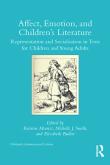 3210915380222108460.jpg
3210915380222108460.jpg
Image courtesy of publisher's website.
y
 Affect, Emotion, and Children's Literature : Representation and Socialisation in Texts for Children and Young Adults
anthology
Affect, Emotion, and Children's Literature : Representation and Socialisation in Texts for Children and Young Adults
anthology
 Affect, Emotion, and Children's Literature : Representation and Socialisation in Texts for Children and Young Adults
anthology
Affect, Emotion, and Children's Literature : Representation and Socialisation in Texts for Children and Young Adults
anthology
Issue Details:
First known date:
2018...
2018
Affect, Emotion, and Children's Literature : Representation and Socialisation in Texts for Children and Young Adults
